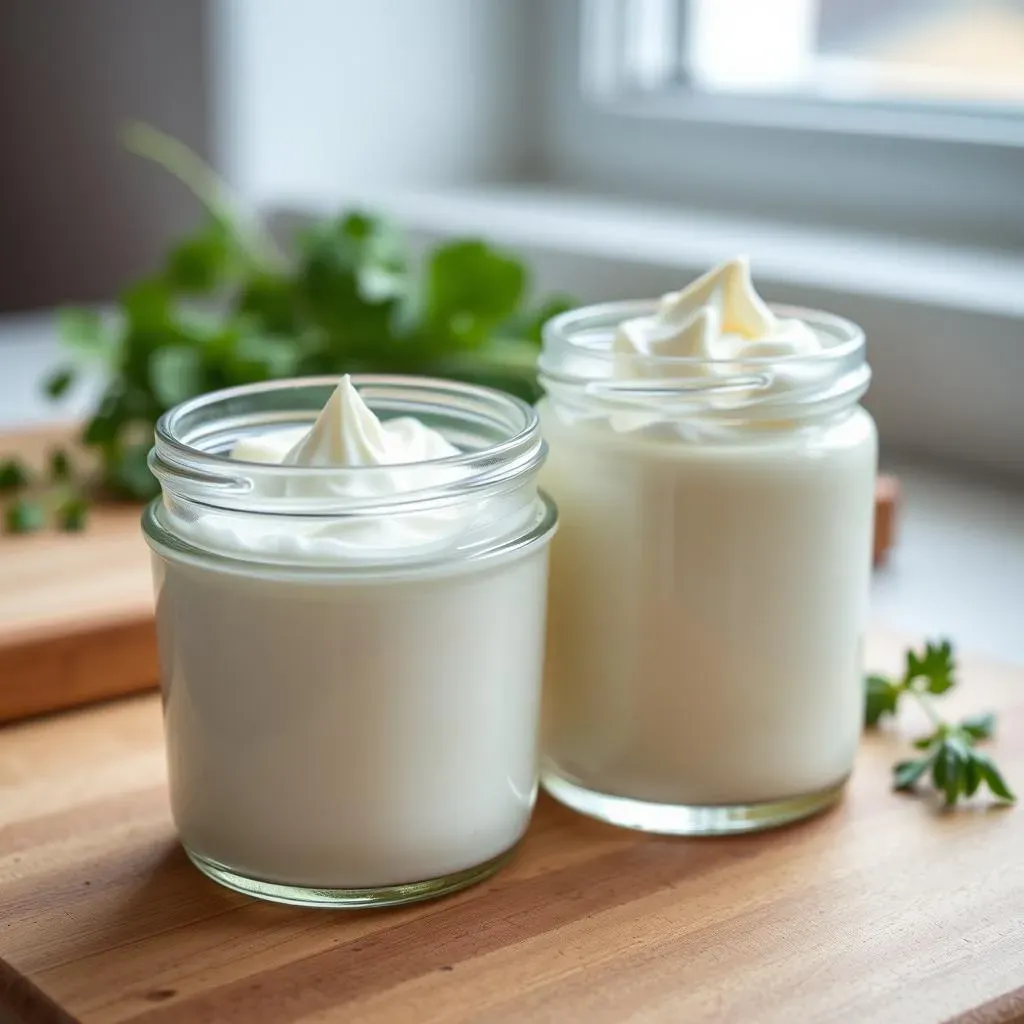Table of Contents
Ever stared into your fridge, recipe in hand, only to discover you're out of sour cream? Don't panic! This article tackles the burning question: "Can I substitute sour cream with Greek yogurt?" We'll go beyond a simple yes or no, exploring the nuances of this common kitchen swap. We’ll directly compare sour cream and Greek yogurt, examining their textures, tastes, and fat content to understand their similarities and differences. Then, we’ll dive into practical applications, showing you where this substitution shines and where it might fall short. We'll explore specific recipes and cooking techniques, offering tips for seamless substitutions to ensure your dishes turn out perfectly. Finally, we'll address potential problems and offer alternative solutions for when Greek yogurt just isn't the right fit. Get ready to master this essential kitchen skill and unlock a world of culinary flexibility!
Greek Yogurt as a Sour Cream Substitute: A Direct Comparison

Greek Yogurt as a Sour Cream Substitute: A Direct Comparison
Texture and Consistency
Let's talk texture. Sour cream boasts a wonderfully smooth, almost velvety consistency. It's thick and rich, clinging beautifully to chips or spreading easily on a baked potato. Greek yogurt, on the other hand, can vary. Full-fat Greek yogurt comes closest to matching sour cream's thickness, but even then, it often has a slightly thinner, more "set" texture. Think of it like this: sour cream is a luxurious cream, while Greek yogurt is a more substantial, slightly drier yogurt. For some recipes, this difference is negligible; for others, it can be a deal breaker. If you're aiming for a super-smooth, creamy texture, you might want to consider other options, like heavy cream as a substitute, depending on the recipe.
The thickness of Greek yogurt can also depend on the brand and fat content. Some brands are thicker than others, and full-fat varieties generally provide the closest match to sour cream's richness. If you're using a lower-fat Greek yogurt, you might find that it’s too thin for certain applications. In baking, for instance, a thinner yogurt might lead to a slightly drier final product. For a more in-depth guide on baking substitutions, check out our guide on substituting sour cream for buttermilk in baking.
Characteristic | Sour Cream | Greek Yogurt |
|---|---|---|
Texture | Smooth, velvety, thick | Thicker than regular yogurt, but can vary; full-fat is closest |
Fat Content | High | Can vary (full-fat is closest to sour cream) |
Taste and Acidity
Now, let's talk taste. Sour cream has a distinctly tangy, slightly acidic flavor. It's often described as subtly salty and refreshingly tart. Plain Greek yogurt shares that tangy quality, although it can be a bit more intense and less subtly salty than sour cream. The level of tartness in Greek yogurt can also depend on the brand. Some are sharper than others. This difference in taste profile can be significant, particularly in dishes where the sour cream flavor is a key element. If you're using Greek yogurt in a dish where the sour cream flavor is a star, you might need to adjust other seasonings to compensate for the difference in taste. For example, you may need to add a pinch of salt or a squeeze of lemon juice to balance out the flavors. This is especially true when substituting sour cream for cream cheese in certain dishes.
Consider this: Would you swap a dollop of sour cream on a baked potato with a dollop of Greek yogurt? Probably! The tang complements the potato beautifully. But would you use Greek yogurt in place of sour cream in a delicate sauce? That’s where you might run into some trouble. The stronger tang of the yogurt could overpower the more subtle flavors of the sauce. Think about the specific recipe and how the sour cream contributes to the overall taste before making the swap. For more tips on using Greek yogurt in different recipes, see our article on using Greek yogurt as a sour cream substitute.
- Sour cream: Tangy, subtly salty, creamy
- Greek yogurt: Tangy (can be more intense), less salty
Successful Swaps: Recipes and Cooking Applications

Successful Swaps: Recipes and Cooking Applications
So, where does Greek yogurt truly shine as a sour cream stand-in? Think dips! A creamy Greek yogurt-based tzatziki sauce is a fantastic example. The tangy yogurt complements cucumbers and garlic beautifully, creating a refreshing dip for pita bread or veggies. You can easily adjust the consistency by adding a bit more yogurt or a little water if needed. For a richer flavor, try adding a dollop of heavy cream to your tzatziki. It's a simple swap that elevates the entire dish.
Moving on to baking, Greek yogurt can be a surprisingly good substitute in many recipes. In muffins or cakes, it adds moisture and a subtle tang that enhances the overall flavor profile. Just be mindful that the texture might be slightly different, as we discussed earlier. For instance, if you are making a recipe that calls for sour cream, substituting it with Greek yogurt might result in a slightly denser cake. For more tips on baking with yogurt, you should check out our guide on substituting sour cream for yogurt in baking.
- Dips and Spreads (Tzatziki, etc.)
- Baking (Muffins, cakes, etc.) - Note potential texture changes
- Savory dishes (chili, stews) - Use sparingly
Let's not forget about savory dishes! A small amount of Greek yogurt can add richness and a subtle tang to chili or stews. However, use it sparingly, as too much can overpower the other flavors. Remember, we're aiming for enhancement, not a flavor takeover! A great alternative would be to use buttermilk instead, depending on the specific dish and your desired outcome.
One area where Greek yogurt often excels is in topping baked potatoes. The tangy creaminess complements the fluffy potato perfectly, offering a lighter, healthier alternative to traditional sour cream. It’s a simple swap that’s both tasty and nutritious. If you're looking for a richer, more decadent topping, consider adding some shredded cheese or chives to your Greek yogurt. For more information on alternative toppings, you might want to check out our article on substituting sour cream for cream cheese in different contexts.
Recipe Type | Successful Swap? | Notes |
|---|---|---|
Dips | Yes | Excellent! Adds creaminess and tang. |
Baking | Mostly yes | May affect texture slightly. |
Savory Dishes | Yes (use sparingly) | Adds depth of flavor. |
Troubleshooting and Alternatives: When Greek Yogurt Doesn't Quite Work

Troubleshooting and Alternatives: When Greek Yogurt Doesn't Quite Work
Sometimes, despite our best intentions, Greek yogurt just isn't the right fit. Its stronger tang might overpower delicate flavors in sauces or dressings. If your recipe calls for a subtle sour cream tang, and you find the Greek yogurt is too assertive, consider reducing the amount or adding a touch of sweetness, like a pinch of sugar or a dash of honey, to balance it out. You could also try adding a bit of lemon juice to boost the acidity and mimic sour cream's bright character. Remember, small adjustments can make a big difference!
If the texture is the issue—if your Greek yogurt is too thin for a particular recipe—you can thicken it up. Simply strain the yogurt through cheesecloth for a few hours. This removes excess whey, resulting in a thicker, creamier consistency. Alternatively, you could gently heat the Greek yogurt on the stovetop to reduce its liquid content; just be careful not to let it boil! However, for recipes requiring a truly thick and luscious texture, you might want to explore other options altogether. For instance, check our guide on using heavy cream as a substitute for a richer, creamier result.
- Reduce Greek yogurt quantity
- Add a touch of sweetness (sugar, honey)
- Add lemon juice for extra brightness
- Strain yogurt to thicken
- Gently heat yogurt to reduce liquid
Let's say you're baking and need that sour cream's contribution to moisture and richness, but the Greek yogurt's tang is throwing off the delicate balance of flavors in your cake. In this scenario, you could experiment with a blend. Try mixing half Greek yogurt and half full-fat plain yogurt to achieve a milder flavor and a creamier texture. It might just be the perfect compromise. For more ideas on baking substitutions, see our article on substituting sour cream for buttermilk in baking recipes.
And if all else fails, don't be afraid to embrace alternative substitutes! Depending on your recipe, options like crème fraîche (for a richer, less tangy flavor), sour milk (for a tangier profile), or even mayonnaise (in certain savory applications) could work wonders. Remember, culinary creativity involves a bit of experimentation, and sometimes a different approach is precisely what your dish needs. For more details on alternative options, you might find our article on sour cream substitutes helpful.
Problem | Solution | Alternative |
|---|---|---|
Too tangy | Reduce amount, add sweetness | Crème fraîche |
Too thin | Strain, gently heat | Sour milk |
Baking issues | Blend with plain yogurt | Mayonnaise (savory) |